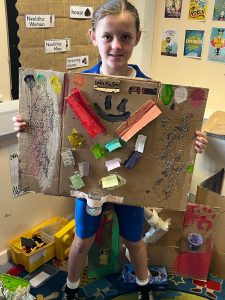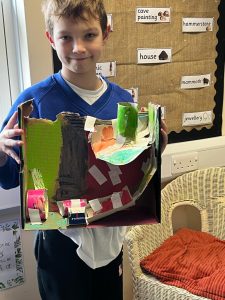Design Technology Lead – Miss R Thompson
Whole school art and DT plan 23-24
Curriculum intent
In Saints Peter and Paul’s we want our children to follow a Design Technology curriculum which develops learning and results in the acquisition of knowledge and skills. Children will know more, remember more and understand more. We aim to create a design technology curriculum with appropriate subject knowledge, skills and understanding as set out in the National Curriculum Design Technology Programmes of study, to provide a balanced and progressive curriculum which promotes the spiritual, moral, cultural, mental and physical development of pupils and prepares them for the opportunities and responsibilities and experiences for later life.
Design and technology is an inspiring, rigorous and practical subject. Using creativity and imagination, pupils design and make products that solve real and relevant problems within a variety of contexts, considering their own and others’ needs, wants and values. They acquire a broad range of subject knowledge and draw on disciplines such as mathematics, science, engineering, computing and art. Pupils learn how to take risks, becoming resourceful, innovative, enterprising and capable citizens. Through the evaluation of past
and present design and technology, they develop a critical understanding of its impact on daily life and the wider world. High-quality design and technology education makes an essential contribution to the creativity, culture, wealth and well-being of the nation.
At Saints Peter and Paul, we aim to provide the opportunity for all children to design, make and evaluate various products throughout the year, each covering various key skills allowing for progression. This will be taught through topic.
Across the school, pupils will be taught the knowledge, understanding and skills needed to engage in an iterative process of designing and making. They will learn this through a range of contexts.
Curriculum implementation
At Saints Peter and Paul’s, our Design and Technology curriculum has been designed to provide learning opportunities for each year group and phase, ensuring learning, knowledge and skills are embedded and progressive, giving children meaningful and purposeful opportunities for learning.
Each year group explores a food technology topic which is implemented across the Key Stages with children developing an understanding of where food comes from, the importance of a varied and healthy diet and how to prepare some dishes. In each phase children will explore, research, design, make and evaluate mechanisms, structures and textiles by designing products with a purpose in mind and intended user of the products, building progressively on the previous phases learning, knowledge and skill.
The Design and Technology curriculum is implemented in two topic days each term, where the children will immerse themselves into researching, designing, making and evaluating and range of real life products. This gives purpose to learning and allows children to display the skills they have learnt with pride.
Although the Design and Technology curriculum is taught discreetly, children are encourage to use their skills cross curricular, for example, making Viking longboats, a Roman Coliseum or designing a product as part of their literacy work.
EYFS
In the EYFS children are encouraged to explore and use a variety of media and materials during a combination Continuous and Enhanced Provision as well as some adult led activities. Children are given opportunities to:
- Use different media and materials to express their own ideas. e.g. Making clay models, constructing rockets from junk modelling materials.
- Begin to make plans and construct with a purpose in mind, using a variety of resources. E.g. drawing designs in the construction area.
- Use what they know about different media and materials in original ways, not being afraid to explore and try new things.
- Learn how to use simple tools and techniques appropriately, effectively and safely
- Identify foods that are good or not good for them and learn how to prepare some foods hygienically.
In Early Years, we want our children to have lots of active, hands-on experiences that encourage their communication and language skills. We nurture our children in becoming critical and creative thinkers by giving them limitless opportunities to design, make and evaluate their models, creations and designs.
Aims
The national curriculum for design and technology aims to ensure that all pupils:
develop the creative, technical and practical expertise needed to perform everyday tasks confidently and to participate successfully in an increasingly technological world build and apply a repertoire of knowledge, understanding and skills in order to design and make high-quality prototypes and products for a wide range of users critique, evaluate and test their ideas and products and the work of others understand and apply the principles of nutrition and learn how to cook.
Attainment targets
By the end of each key stage, pupils are expected to know, apply and understand the matters, skills and processes specified in the relevant programme of study.
Subject content
Key stage 1
Through a variety of creative and practical activities, pupils should be taught the knowledge, understanding and skills needed to engage in an iterative process of designing and making. They should work in a range of relevant contexts [for example, the home and school, gardens and playgrounds, the local community, industry and the wider environment].
When designing and making, pupils should be taught to:
Design
design purposeful, functional, appealing products for themselves and other users based on design criteria generate, develop, model and communicate their ideas through talking, drawing, templates, mock-ups and, where appropriate, information and communication technology
Make
select from and use a range of tools and equipment to perform practical tasks [for example, cutting, shaping, joining and finishing] select from and use a wide range of materials and components, including construction materials, textiles and ingredients, according to their characteristics
Evaluate
explore and evaluate a range of existing products evaluate their ideas and products against design criteria
Technical knowledge
build structures, exploring how they can be made stronger, stiffer and more stable explore and use mechanisms [for example, levers, sliders, wheels and axles], in their products.
Subject content
Key stage 2
Through a variety of creative and practical activities, pupils should be taught the knowledge, understanding and skills needed to engage in an iterative process of designing and making. They should work in a range of relevant contexts [for example, the home, school, leisure, culture, enterprise, industry and the wider environment]. When designing and making, pupils should be taught to:
Design
use research and develop design criteria to inform the design of innovative, functional, appealing products that are fit for purpose, aimed at particular individuals or groups generate, develop, model and communicate their ideas through discussion, annotated sketches, cross-sectional and exploded diagrams, prototypes, pattern pieces and computer-aided design
Make
select from and use a wider range of tools and equipment to perform practical tasks [for example, cutting, shaping, joining and finishing], accurately select from and use a wider range of materials and components, including construction materials, textiles and ingredients, according to their functional properties and aesthetic qualities
Evaluate
investigate and analyse a range of existing products, evaluate their ideas and products against their own design criteria and consider the views of others to improve their work understand how key events and individuals in design and technology have helped shape the world
Technical knowledge
apply their understanding of how to strengthen, stiffen and reinforce more complex structures understand and use mechanical systems in their products [for example, gears, pulleys, cams, levers and linkages] Understand and use electrical systems in their products [for example, series circuits incorporating switches, bulbs, buzzers and motors] apply their understanding of computing to program, monitor and control their products.
Cooking and nutrition
As part of their work with food, pupils should be taught how to cook and apply the principles of nutrition and healthy eating. Instilling a love of cooking in pupils will also open a door to one of the great expressions of human creativity. Learning how to cook is a crucial life skill that enables pupils to feed themselves and others affordably and well, now and in later life.
Pupils should be taught to:
Key stage 1
use the basic principles of a healthy and varied diet to prepare dishes understand where food comes from.
Key stage 2
understand and apply the principles of a healthy and varied diet prepare and cook a variety of predominantly savoury dishes using a range of cooking techniques understand seasonality, and know where and how a variety of ingredients are grown, reared, caught and processed.
Impact
Children have a set of DT skills embedded. They can talk about real life designers or designs and the impact they have had on the world. They have developed and become confident in the many characteristics of learning such as: resilience, resourcefulness, creativity and problem solving.


